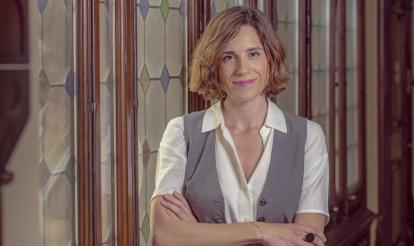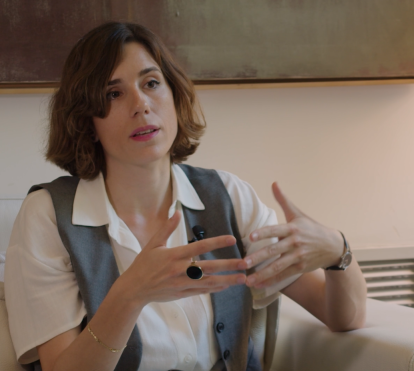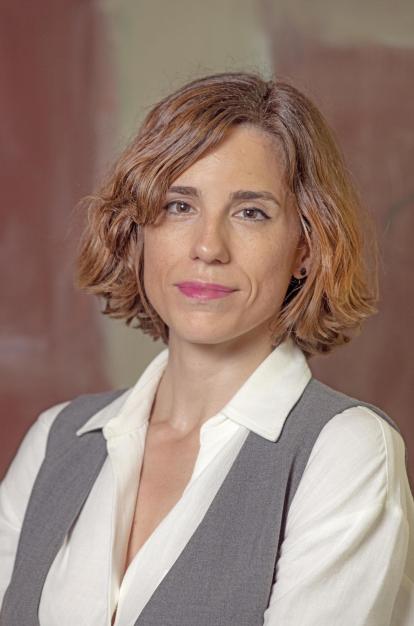
You are reading:

You are reading:

13.06.24
9 minutes readOne in three people in Europe is, at one time or another, a victim of age-related discrimination. Despite progress towards more diverse societies, prejudice of this kind continues to manifest itself in all areas, including employment, social and cultural spheres, limiting opportunities for a large part of the population. The inappropriate use of words such as grandad, dinosaur or fogy denote ageism towards older adults, as stated in the Ageism Glossary (in Spanish) promoted by the ”la Caixa” Foundation. Along these lines, Dr Vânia de la Fuente-Núñez, who received a postgraduate fellowship from the ”la Caixa” Foundation in 2013 to study for a master’s degree at University College London, is collaborating with the programme for the Elderly of the ”la Caixa” Foundation. An international expert in healthy ageing and ageism, she has led the WHO’s Global Campaign to Combat Ageism and now works as an independent consultant advising governments and public and private organisations to improve the lives of older people.
How would you define ageism?
Ageism is a combination of three things – stereotypes, prejudice and discrimination – that we apply to other people or ourselves on the basis of age. Stereotypes are the way we think, prejudice is the way we feel and discrimination is the way we act. And it’s important to consider all three factors because they influence each other. It is important to consider these three factors because they influence each other. For example, using infantilising language with older people, which is one way of behaving, makes us think that they have cognitive impairment or hearing problems, in other words, it affects our way of thinking. All three dimensions need to be considered together.
You say it doesn’t just affect older people…
We can be victims of ageism throughout our lives. In fact, it’s the only “ism” that we all suffer from. However, it’s a phenomenon that tends to be concentrated in two stages: youth and old age. In Europe, for example, we know that one in three people reports experiences of ageism, with younger and older people reporting it most.
What is the relationship between ageism and other forms of discrimination?
When different characteristics are used to discriminate against someone, they create intersections between each other. Not only do the biases add up, but they also reinforce each other. For example, at the intersection of sexism and ageism, we see that older women bear the brunt. As they get older, their social status declines disproportionately compared to that of men, with far greater pressure to hide any signs of age. And they’re excluded and discriminated against in different settings, such as health and work, where it seems women are never the right age.

Is there more ageism in some cultures than in others?
Ageism is everywhere, no country is free of it. What is surprising is that, in the case of older people, the phenomenon is more pronounced in low and lower-middle income countries. This is puzzling because of the stereotypes associated with parts of Africa and South-East Asia, where the value of filial piety, caring for our parents in old age, is highly valued. This was thought to be incompatible with the existence of ageism, but that’s not the case.
What is the situation in Spain?
Currently, around 50% of the Spanish population perceives that there is age discrimination towards people aged 55 and over. Although we don’t have data on ageism towards young people, the number of persons in this age group who report having experienced it leads us to believe that the figure may be similar.
Being a child, an adult or an older person is obvious at first glance. To what extent is it possible to treat someone without being influenced by their age?
Age is one of the first things we notice when we interact with another person, just as we can see the colour of their skin or whether they are a man, woman or of another gender; but all it tells us is the number of years they’ve lived. Ageism arises when this characteristic is instrumentalised and used to categorise and divide, when we think that all people born in a certain era are a certain way and deserve to be treated differently. This creates a series of problems that we see everywhere, not only in institutions, but also in the relationships we have with each other and even with ourselves.

What about stereotypes that seem positive, such as having to respect older people?
We should respect people because they are people, not because they’re of a certain age. Another stereotype is that older people are wise, but you can be many years old and not know more than a person of fifteen. In the end it’s something that depends on the experience and knowledge we’ve acquired, it has nothing to do with age. It’s important to point out that, although there are stereotypes that are considered positive, they are generalisations that are made without knowing the individuals, only on the basis of their date of birth. Consequently, they can be equally prejudicial.
How do positive discrimination and anti-ageism coexist?
Positive discrimination seeks to correct inequalities that have occurred historically and systemically. The important thing is to implement it based on evidence that demonstrates its necessity. If we look at employment data in Spain, for example, we see that at the end of last year, 50% of the unemployed were concentrated in the 20-29 age group on the one hand, and the 50-59 age group on the other. Positive discrimination policies can help groups that are systematically excluded from the labour market. What’s crucial is that they are data-driven and evaluated over time so they don’t perpetuate stereotypes and to ensure they serve their purpose without causing negative side effects.
Life expectancy is increasing. Is that why greater differences are arising between generations?
There have always been older people, and perhaps ageism too. In fact, there are texts by Aristotle, for example, in which he speaks quite badly of old age. It’s not just a contemporary phenomenon. As for the differences between generations, I think that increased longevity is a huge gain in diversity that opens up opportunities for living together. The discourse of supposed differences between generations is greatly exaggerated, manipulated and exploited, both by the media and at the political level. It generates more clicks and diverts attention from the fact that many of the problems faced by both older and younger people are common and could be worked on and addressed together.
What role do the media play in propagating this discourse?
The media have a very important role to play because they influence our understanding of reality. We have to fight against the stereotyping of age groups, like we saw during the pandemic, which was terrible, when young people were systematically characterised as selfish and invincible, and older people as vulnerable and dependent. Another aspect related to communication is that people over 65 in Spain make up 20% of the population, but if you turn on the TV they’re invisible, it’s as if they don’t exist. You walk down the street and they’re there. Why don’t they have a role in the media?
Is it because the cult of youth dominates?
The media have a crucial role to play in the fight against the anti-ageing discourse, which is starting earlier and earlier. There are women in their 20s or younger who are already trying not to look older. This is something that turns the passage of time into a real nightmare for millions of women worldwide. On the other hand, it’s also important to highlight that youth is idealised as an abstract concept, while in reality there’s also a lot of discrimination against young people.

What measures are being taken against ageism in the world?
Fortunately, I’ve been able to see and contribute to many initiatives at the global level. In the Americas region, for example, the Inter-American Convention on Protecting the Human Rights of Older Persons has been created, which is the first legally binding instrument that ensures, protects and promotes rights in old age. I would also highlight intergenerational activities carried out in different countries, such as a programme in the city of Porto, where young people in need of affordable housing live with older people who share their homes because they don’t want to live alone. There are similar intergenerational programmes in Spain, such as Viure i Conviure in Barcelona.
Is there also a need for action at the educational level?
What we know is that at the age of four we’re already aware of the age stereotypes that exist in our culture, because we see how our relatives interact with other people, and the influence of television, etc. It’s something we internalise little by little until we apply it to ourselves. That’s why we need educational activities that allow us to talk about ageing. When you’re 10 years old and you’re asked what you want to be when you grow up, your imagination takes you to your 20- or 30-year-old self, at most. It’s a pity, because it prevents us from thinking of old age as a stage of life that you can enjoy just as much as the others.
You led the WHO’s Global Campaign to Combat Ageism and continue to fight against it in Spain and abroad. In perspective, what is your assessment?
I think we’ve achieved unprecedented change, thanks in large part to the launch of the first United Nations Global Report on Ageism in 2021, which helped raise the profile of the problem and put a range of solutions on the table. We spent a lot of time researching and compiling the evidence, investigating to understand the true scale and impact of the problem and to identify effective strategies to tackle it. Currently, we know that 93 countries now have programmes and policies in place to tackle ageism, and 105 countries have legislation prohibiting age discrimination. Another important aspect is that, thanks to these efforts, the word edadismo [ageism] is included in Spanish, Galician and Catalan dictionaries, for example. If you don’t have a word for a concept, it’s as if it doesn’t exist. We still have challenges, but I see more and more interest from organisations and governments and even ordinary people who want to learn more and take action. A world for all ages is within our reach.